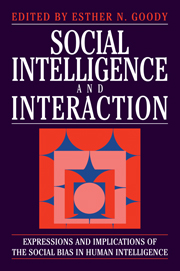 Social Intelligence and Interaction
Social Intelligence and Interaction Book contents
- Frontmatter
- Contents
- List of contributors
- Conventions used in transcripts
- Preface
- Introduction: some implications of a social origin of intelligence
- Part I Primary processes
- 1 The ape legacy: the evolution of Machiavellian intelligence and anticipatory interactive planning
- 2 How to invent a shared lexicon: the emergence of shared form-meaning mappings in interaction
- 3 Hunter-gatherers' kinship organization: implicit roles and rules
- Part II The interactive negotiation of meaning in conversation
- Part III Genres as tools that shape interation
- Part IV Expressions of a social bias in intelligence
- Consolidated bibliography
- Index
3 - Hunter-gatherers' kinship organization: implicit roles and rules
Published online by Cambridge University Press: 09 January 2010
- Frontmatter
- Contents
- List of contributors
- Conventions used in transcripts
- Preface
- Introduction: some implications of a social origin of intelligence
- Part I Primary processes
- 1 The ape legacy: the evolution of Machiavellian intelligence and anticipatory interactive planning
- 2 How to invent a shared lexicon: the emergence of shared form-meaning mappings in interaction
- 3 Hunter-gatherers' kinship organization: implicit roles and rules
- Part II The interactive negotiation of meaning in conversation
- Part III Genres as tools that shape interation
- Part IV Expressions of a social bias in intelligence
- Consolidated bibliography
- Index
Summary
This chapter offers an analysis of the emergence of explicitly institutionalized roles and rules based on kinship (Kinship roles and rules) among Nayaka. They provide a case of ‘hunter-gatherers’, with the simplest known social organization called band-organization. While analysis of this kind of organization has been traditionally informed by an ecological-evolutionary paradigm, the present analysis is informed by Berger and Luckmann's The Social Construction of Reality (1966). The analysis was inspired by Goody's AIP project, which calls for examining human practices in relation to evolutionary programmed anticipatory interactive planning (AIP). The analysis aims to contribute to the project, in reciprocity, a perspective on hunter-gatherers that can raise hypotheses about the possible contribution of AIP to the emergence of human roles and rules.
I shall first outline the conceptual links that lead from the AIP idea to the analysis. Then I shall examine the Nayaka social scene, and their kinship system (terms, cooperation, and avoidance). Finally, I shall offer a comparative perspective, and reflect back on AIP concerns.
Theoretical links
The AIP idea started from primate research. Challenging the traditional view that goes back to Darwin and Wallace, students of high primates recently suggested that the principal selective pressure behind the evolution of ‘higher intellectual faculties’ lay not in technical dealings with the physical environment but, instead, in everyday dealings with social associates (Byrne and Whiten 1988; Humphrey 1976; Jolly 1966a). They argued that living within social groups, early hominids had – like chess players – to foresee others' actions in order to preempt or exploit these actions to their own advantage.
- Type
- Chapter
- Information
- Social Intelligence and InteractionExpressions and implications of the social bias in human intelligence, pp. 68 - 84Publisher: Cambridge University PressPrint publication year: 1995
- 3
- Cited by


